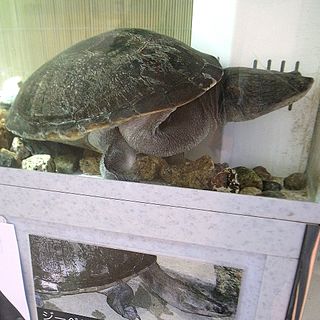
The Arrau turtle, also known as the South American river turtle, giant South American turtle, giant Amazon River turtle, Arrau sideneck turtle, Amazon River turtle or simply the Arrau, is the largest of the side-neck turtles (Pleurodira) and the largest freshwater turtle in Latin America. The species primarily feeds on plant material and typically nests in large groups on beaches. Due to hunting of adults, collecting of their eggs, pollution, habitat loss, and dams, the Arrau turtle is seriously threatened.

The yellow-spotted Amazon river turtle, also known commonly as the yellow-headed sideneck turtle and the yellow-spotted river turtle, and locally as the taricaya, is one of the largest South American river turtles. It can grow up to 45 cm long and weigh up to 8 kg. This species can be recognized by its black or brown oval carapace with distinctive low keels on the second and third scutes. Yellow spots on the side of its head give this species its common name. These spots are most prominent in juveniles and fade with age. Females can be up to twice the size of males.

The eastern long-necked turtle is an east Australian species of snake-necked turtle that inhabits a wide variety of water bodies and is an opportunistic feeder. It is a side-necked turtle (Pleurodira), meaning that it bends its head sideways into its shell rather than pulling it directly back.

Sulawesi tortoise or Forsten's tortoise is a species of tortoise in the family Testudinidae. Is native to sulawesi island, indonesia.

Macrochelys is a genus of very large freshwater turtles in the family Chelydridae from Southeastern United States. Only a single extant species was recognized until a 2014 study divided it into two, or possibly three species.

The New Guinea snake-necked turtle is a species of turtle in the family Chelidae. The species is found almost exclusively within Western Province, Papua New Guinea.
Pritchard's snake-necked turtle is a species of turtles in the family Chelidae. The species is endemic to a restricted area of Central Province, Papua New Guinea.

The Western New Guinea stream turtle or New Guinea snapping turtle is a species of freshwater turtle in the Chelidae family. It is found in the Bird's Head Peninsula and the Bomberai Peninsula west of Cenderawasih Bay, and on the island of Waigeo of West Papua, Indonesia.
Pelusios broadleyi, commonly known as the Turkana mud turtle, Broadley's mud turtle, or the Lake Turkana hinged terrapin, is a species of turtle in the family Pelomedusidae. The species is native to eastern Africa.

The red-headed Amazon side-necked turtle, red-headed river turtle or red-headed sideneck is a species of turtle in the family Podocnemididae. It is found in the Amazon basin in Brazil, Colombia, and Venezuela.

Chelodina (Chelydera) burrungandjii, the sandstone snake-necked turtle or Arnhem Land long-necked turtle, is a medium-sized turtle reaching carapace lengths of 316 mm. The species is found in the sandstone plateaus and escarpments and the plunge pools of Arnhem Land of the Northern Territory. The species had been long recognised as valid. However, it had been difficult to research due to the remoteness of its habitat. Efforts to breed this species in captivity had been largely unsuccessful, until National Aquarium Herpetologist Matthew Benedict lead a successful breeding project in 2021. The species occurs in proximity to Chelodina rugosa, to which it is closely related. For the most part the two species are parapatric in distribution. However, they do come together in limited locations such as plunge pools at the base of the escarpments. In these areas there is hybridization between the species.

The Myanmar brown leaf turtle is a species of Asian leaf turtle found in Myanmar.

The western black-bridged leaf turtle is a species of Asian leaf turtle found in southern Indochina.

Elseya schultzei, commonly known as Schultze's snapping turtle, is a species of chelid turtle endemic to northern New Guinea.

Chelodina (Chelydera) kuchlingi, commonly known as Kuchling's long-necked turtle or Kuchling's turtle, is a species of freshwater turtle in the family Chelidae. The species is endemic to Australia.
Chelodina walloyarrina, the Kimberley long neck turtle,Kimberley snake-necked turtle, is a large species of long neck turtle endemic to the Kimberley region of Western Australia. In recent years, it has been unclear as to whether this was a valid species or not. It has been recognised as such by the 2017 version of the Turtle Checklist.
The Apalachicola snapping turtle is a proposed species that lives in the Apalachicola River, United States. The species can as well be found within other panhandle rivers within the states of Florida, Georgia, and Alabama.. It has traditionally been included as part of the widespread species M. temminckii, but an analysis in 2014 recommended treating it as distinct. A study published the following year considered this change unwarranted and recommended that M. apalachicolae should be considered a junior synonym of M. temminckii, and this is followed by the Reptile Database, IUCN's Tortoise and Freshwater Turtle Specialist Group, and the Committee On Standard English And Scientific Names. The Apalachicola snapping turtles and other species of snapping turtle have been classified as endangered due to human activity which is causing the destruction to their natural habitats

The Sonoran Desert tortoise, or Morafka's desert tortoise, is a species of tortoise native to the Sonoran Desert.

Scott A. Thomson is an Australian herpetologist, paleontologist, and taxonomist, specialising in turtles of the family Chelidae.
Chelodina gunaleni or Gunalen's snake-necked turtle is a turtle species in the family Chelidae. The species is endemic to the lowlands of west-central West Papua, Indonesia, south of the central ranges.
















